The HVAC Control System Market is estimated to be valued at USD 22.9 billion in 2025 and is projected to reach USD 57.9 billion by 2035, registering a compound annual growth rate (CAGR) of 9.7% over the forecast period.
The HVAC control system market is experiencing steady expansion due to increasing demand for energy-efficient building management and the global emphasis on sustainable infrastructure development. Rising urbanization, growing adoption of smart building technologies, and stricter energy regulations are supporting continuous investments in advanced HVAC systems. The market is being shaped by the integration of IoT, AI-based predictive maintenance, and remote monitoring capabilities, which are improving system efficiency and operational control.
Manufacturers are focusing on developing interoperable and user-friendly solutions to meet the growing complexity of modern commercial and residential environments. The future outlook is supported by rising construction activities and retrofit projects in both developed and emerging economies.
Growing awareness of indoor air quality and temperature optimization is further stimulating product demand Over the forecast period, the market is expected to benefit from digital transformation initiatives, policy incentives for green buildings, and the ongoing shift toward intelligent climate control systems that deliver cost savings and operational reliability.
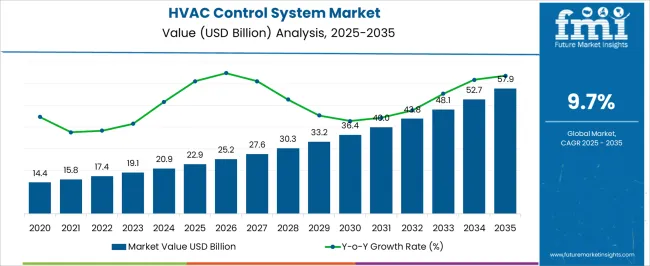
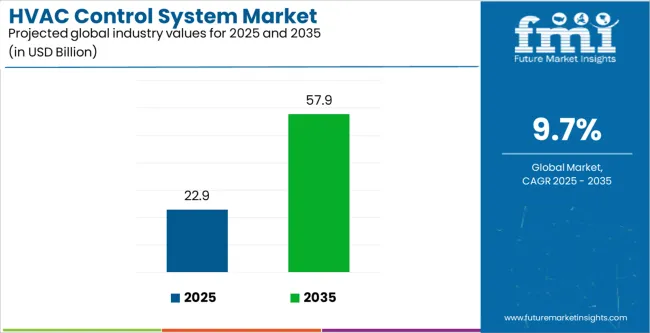
| Metric | Value |
|---|---|
| HVAC Control System Market Estimated Value in (2025 E) | USD 22.9 billion |
| HVAC Control System Market Forecast Value in (2035 F) | USD 57.9 billion |
| Forecast CAGR (2025 to 2035) | 9.7% |
The market is segmented by Type, Implementation, and End-User and region. By Type, the market is divided into Integrated Control, Temperature And Humidity Control, and Ventilation Control. In terms of Implementation, the market is classified into New Construction and Retrofit. Based on End-User, the market is segmented into Commercial, Residential, and Industrial. Regionally, the market is classified into North America, Latin America, Western Europe, Eastern Europe, Balkan & Baltic Countries, Russia & Belarus, Central Asia, East Asia, South Asia & Pacific, and the Middle East & Africa.
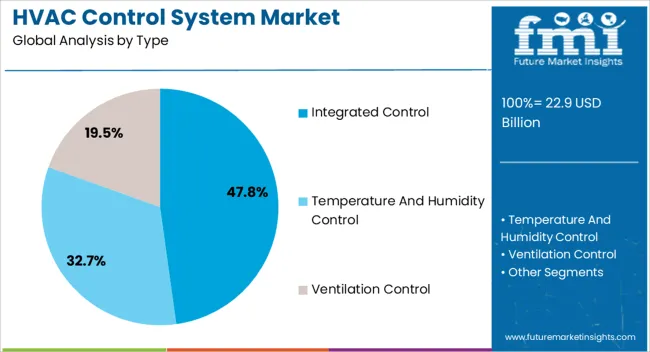
The integrated control segment, representing 47.80% of the type category, has been leading the market due to its ability to unify various HVAC functions, including ventilation, air conditioning, and heating, within a single intelligent framework. Demand for integrated systems has been driven by the need for enhanced energy efficiency and seamless automation in large-scale facilities.
The segment has gained traction as building owners prioritize smart solutions capable of reducing energy wastage and operational downtime. Integration with building management systems has improved centralized monitoring and optimized energy consumption.
Continuous innovation in sensors, analytics, and connectivity protocols has further supported adoption The growing trend toward smart cities and the modernization of existing infrastructure is expected to sustain the segment’s dominance, supported by increasing collaboration between HVAC manufacturers and automation technology providers.
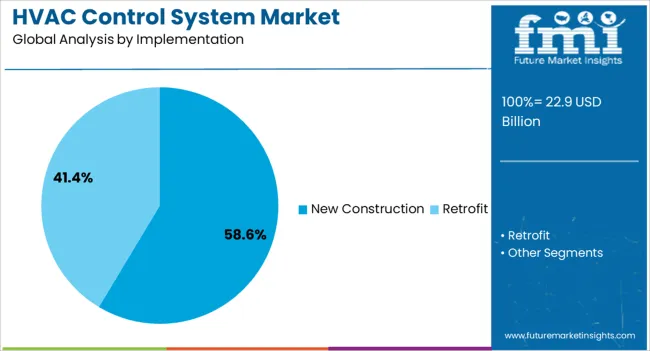
The new construction segment, holding 58.60% of the implementation category, has maintained a leading position owing to rising investments in commercial and residential infrastructure development. Rapid urbanization and government-backed green building initiatives have accelerated demand for advanced HVAC control solutions in newly built facilities.
Integration of smart and energy-efficient systems during the construction phase has become standard practice to ensure long-term operational efficiency. Developers are increasingly adopting HVAC automation to comply with sustainability certification requirements and enhance property value.
The expansion of industrial zones and large-scale real estate projects in emerging economies has further reinforced market growth Over the forecast period, increasing adoption of IoT-enabled control systems and energy optimization software during new construction projects is expected to sustain this segment’s leadership.
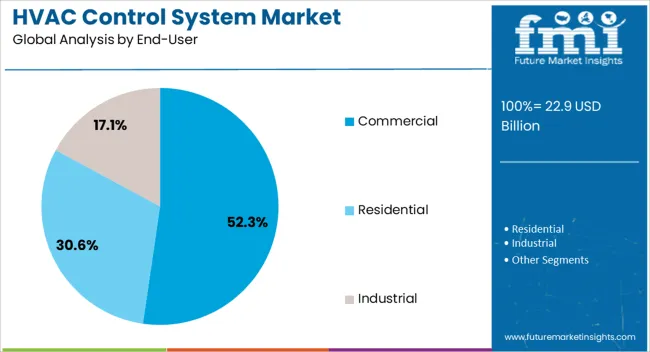
The commercial segment, accounting for 52.30% of the end-user category, has emerged as the leading revenue contributor, driven by widespread adoption across office buildings, retail complexes, hospitals, and educational institutions. Rising focus on operational cost reduction, employee comfort, and compliance with energy standards has encouraged commercial facility managers to invest in intelligent HVAC control systems.
Continuous advancements in automation and cloud-based monitoring platforms have enhanced energy performance tracking and maintenance efficiency. The commercial sector’s preference for scalable and interoperable control systems has strengthened vendor collaborations and technology integration.
Expansion of commercial real estate, along with retrofitting of existing facilities to meet sustainability goals, is expected to sustain demand This segment is projected to remain dominant as the global focus on energy-efficient infrastructure continues to intensify.
This part offers a thorough examination of the industry during the previous five years, with an emphasis on anticipated changes in the heating, ventilation, and air conditioning (HVAC) control system sector. The market is gradually becoming more positive, with a 10.7% historical CAGR. Up to 2035, the industry is expected to grow consistently at a 9.7% CAGR.
| Historical CAGR | 10.7% |
|---|
Numerous kinds of sensors and equipment are used in the heating, ventilation, and air conditioning (HVAC) systems to manage temperature, airflow, and other factors. Electrical problems can also be particularly sensitive to such a complicated arrangement. Because of their complexity, upgrading the current HVAC control systems is difficult, which is predicted to impede the market growth.
Crucial factors that are anticipated to influence the demand for HVAC control systems through 2035.
Industry participants will want to be wise and flexible over the anticipated period, as these qualities position the industry for success in subsequent decades.
Integration of IoTs Develops Robust HVAC Control System
The demand for HVAC control systems has expanded dramatically due to their integration with IoT and smart technologies. Real-time HVAC performance monitoring is made possible by these systems, which enables facility managers and owners to spot problems and make well-informed decisions.
To minimize downtime and increase equipment longevity, they also employ machine learning algorithms and data analytics to forecast equipment breakdowns and maintenance requirements. The system's dependability, effectiveness, and maintenance cost are all optimized by this proactive strategy.
IoT-enabled HVAC control systems also enable precise control and optimization of energy consumption, adjusting settings based on occupancy patterns, weather conditions, and energy demand. Advanced energy management features, including demand response capabilities and load balancing algorithms, enable buildings to participate in energy-saving programs and optimize energy efficiency during peak demand periods.
These advancements contribute to cost savings, sustainability, and occupant comfort, making IoT-enabled HVAC control systems indispensable components of modern building management strategies.
Cloud-Based HVAC Solutions Scales up the Market Growth
The shift towards cloud-based HVAC control systems is a significant advancement in modern building management, enabling scalability, real-time data analytics, and enhanced connectivity across building systems. These systems provide unlimited storage and computing resources, enabling seamless integration of additional sensors, devices, and control points as buildings expand or undergo renovation.
This scalability enables HVAC systems to adapt to changing occupancy patterns, building usage, and environmental conditions while maintaining optimal performance and efficiency.
Real-time data analytics from cloud-based systems provide actionable insights into building performance, energy consumption, and occupant comfort. By aggregating data from sensors, meters, and other IoT devices, these systems can analyze trends, identify anomalies, and predict future outcomes, empowering stakeholders to make data-driven decisions that optimize HVAC operation and energy usage.
Improved communication between building systems makes it possible to monitor and regulate them centrally, facilitating efficient maintenance planning and thorough management of HVAC operations. Cloud-based HVAC control systems are becoming essential tools for building management in the digital era due to the trend toward cloud-based solutions.
Emphasis on Energy Efficiency and Sustainability Demands Eco-Friendly HVAC Solutions and Controls
The growing focus on energy efficiency and sustainability drives the demand for eco-friendly HVAC solutions and controls. Governments and regulatory bodies worldwide are implementing stringent energy efficiency regulations to reduce greenhouse gas emissions and promote sustainable building practices. The alteration has significant implications for HVAC systems, which account for a substantial portion of a building's energy consumption.
Eco-friendly HVAC solutions offer significant savings over traditional ones, with long-term benefits often outweighing the initial costs. Governments and utilities offer incentives, rebates, and financing programs to encourage the adoption of energy-efficient heating, ventilation, and air conditioning (HVAC) technologies.
Industries also recognize the importance of corporate social responsibility (CSR) and environmental stewardship in building brand reputation and maintaining competitiveness. Eco-friendly HVAC solutions improve indoor air quality, occupant comfort, and health outcomes.
This section offers in-depth analyses of particular HVAC control system market sectors. The two main topics of the research are the segment with the temperature and humidity control type and the retrofit implementation type segment. Through a comprehensive examination, this section attempts to provide a fuller knowledge of these segments and their relevance in the larger context of the heating, ventilation, and air conditioning (HVAC) solution industry.
| Attributes | Details |
|---|---|
| Top Type | Temperature and Humidity Control |
| CAGR from 2025 to 2035 | 9.4% |
The market for HVAC control systems is driven by the requirement to maintain ideal conditions for ventilation and automation accuracy, which includes controlling temperature and humidity. Registering a promising CAGR of 9.4% from 2025 to 2035, the following drives display the growth of the segment:
| Attributes | Details |
|---|---|
| Top Implementation | Retrofit |
| CAGR from 2025 to 2035 | 9.2% |
During the forecast period, the global HVAC solution and control system market is segmented into retrofit and new construction, with the retrofit segment accounting for a moderate CAGR of 9.2% from 2025 to 2035, the growth drivers are as follows:
United States, China, Japan, South Korea, and the United Kingdom are some of the most predominant nations on the global stage, and this section is anticipated to gaze at their HVAC control system sectors. Examine the several aspects influencing these nations' need for, acceptance of, and interactions with HVAC management via a thorough investigation.
| Countries | CAGR from 2025 to 2035 |
|---|---|
| United States | 9.8% |
| United Kingdom | 11.0% |
| China | 10.6% |
| Japan | 10.4% |
| South Korea | 9.5% |
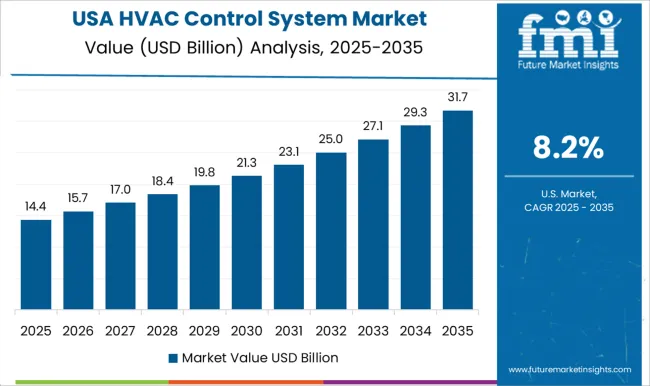
By 2035, the HVAC control system market in the United States brought in USD 22.9 billion in sales. In the upcoming years, the market is anticipated to increase at a compound annual growth rate (CAGR) of 9.8% from 2025 to 2035. These factors are propelling the industry's expansion:
The HVAC control system sector in the United Kingdom is expected to witness substantial growth in the coming years, with an estimated CAGR of 11.0% until 2035. The industry has already shown significant potential, with a CAGR of 14.9% between 2020 to 2025. The market is projected to be valued at USD 2.2 billion, indicating a vast potential for growth and investment in the automobile sector. Here are a few of the major trends:
The HVAC control system market in China is expected to grow at a compound annual growth rate (CAGR) of 10.6%. By 2035, experts predict the industry will be valued at USD 14.4 billion. Between 2020 and 2025, the Chinese heating, ventilation, and air conditioning (HVAC) control market is anticipated to grow at a 12.4% CAGR. Some of the primary trends are:
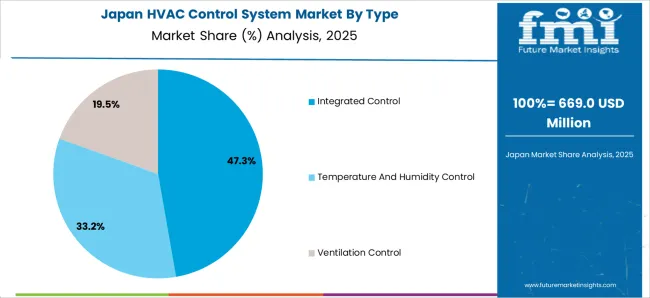
It is anticipated that the demand for HVAC control systems in Japan is likely to register a growth of 10.4% between 2025 to 2035. The construction sector's growing demand for HVAC control systems is expected to propel market growth in the next decade. The market is expected to develop a market valuation of USD 57.9 billion by 2035. Among the primary drivers are:
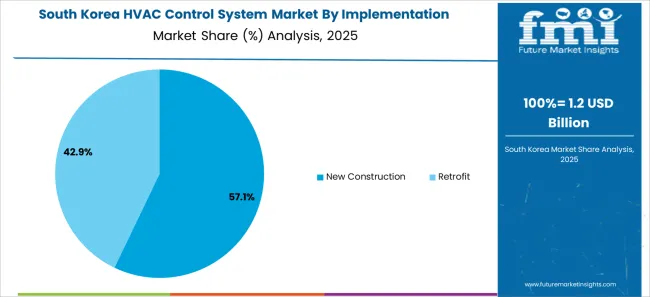
The heating, ventilation, and air conditioning (HVAC) controls market in South Korea is poised for significant growth in the years to come, owing to the rapid development of technical and construction sectors in the province. The demand for HVAC control system is expected to increase at a CAGR of approximately 9.5% from 2025 to 2035 with global valuation of USD 3.1 billion. Some of the primary trends are:
The global HVAC control system market is undergoing significant changes due to the involvement of market players. These enterprises are enhancing system performance, energy efficiency, and user experience through research and development, leading to advanced control algorithms, predictive maintenance solutions, and smart sensors. These advancements push the boundaries of HVAC technology, driving industry progress and differentiation.
Technological advancements like the Internet of Things (IoT), artificial intelligence (AI), and cloud computing are reshaping the HVAC control system landscape, enabling interconnected systems capable of collecting and analyzing data, predicting equipment failures, and optimizing energy usage. This integration enhances system reliability, efficiency, and sustainability, meeting customer needs and regulatory requirements.
Strategic partnerships are being formed with technology providers, building automation companies, and energy management firms to offer comprehensive heating, ventilation, and air conditioning (HVAC) control systems. These partnerships leverage each other's strengths and expertise to deliver value-added solutions that address diverse customer needs.
Stakeholder engagement is also crucial, as companies engage with building owners, contractors, and facility managers to understand their needs and develop customized solutions. This customer-centric approach enables companies to deliver tailored heating, ventilation, and air conditioning (HVAC) control systems that meet specific requirements and provide measurable energy savings, comfort, and indoor air quality benefits.
Recent Developments in the HVAC Control System Industry

The global hvac control system market is estimated to be valued at USD 22.9 billion in 2025.
The market size for the hvac control system market is projected to reach USD 57.9 billion by 2035.
The hvac control system market is expected to grow at a 9.7% CAGR between 2025 and 2035.
The key product types in hvac control system market are integrated control, temperature and humidity control and ventilation control.
In terms of implementation, new construction segment to command 58.6% share in the hvac control system market in 2025.






Full Research Suite comprises of:
Market outlook & trends analysis
Interviews & case studies
Strategic recommendations
Vendor profiles & capabilities analysis
5-year forecasts
8 regions and 60+ country-level data splits
Market segment data splits
12 months of continuous data updates
DELIVERED AS:
PDF EXCEL ONLINE
HVAC Market Size and Share Forecast Outlook 2025 to 2035
HVAC Valve Market Size and Share Forecast Outlook 2025 to 2035
HVAC Air Quality Monitoring Market Size and Share Forecast Outlook 2025 to 2035
HVAC Centrifugal Compressors Market Size and Share Forecast Outlook 2025 to 2035
HVAC Fan & Evaporator Coil Market Size and Share Forecast Outlook 2025 to 2035
HVAC Software Market Analysis - Size, Share, and Forecast Outlook for 2025 to 2035
HVAC Insulation Market Trends & Forecast 2025 to 2035
HVAC System Analyzer Market Size and Share Forecast Outlook 2025 to 2035
HVAC Blower and Fan Systems Market Growth - Trends & Forecast 2025 to 2035
Smart HVAC Controls Market Size and Share Forecast Outlook 2025 to 2035
Global HVAC Filter Market
Marine HVAC System Market Size and Share Forecast Outlook 2025 to 2035
Automotive HVAC Blower Market Trends - Size, Share & Growth 2025 to 2035
Automotive HVAC Ducts Market Growth - Trends & Forecast 2025 to 2035
Latin America Automotive HVAC Market Size and Share Forecast Outlook 2025 to 2035
Control Room Solution Market Size and Share Forecast Outlook 2025 to 2035
Control Knobs for Panel Potentiometer Market Size and Share Forecast Outlook 2025 to 2035
Controlled-Release Drug Delivery Technology Market Size and Share Forecast Outlook 2025 to 2035
Controlled Environment Agriculture (CEA) Market Size and Share Forecast Outlook 2025 to 2035
Control Cable Market Size and Share Forecast Outlook 2025 to 2035

Thank you!
You will receive an email from our Business Development Manager. Please be sure to check your SPAM/JUNK folder too.
Chat With
MaRIA